1999 DODGE RAM lock
[x] Cancel search: lockPage 964 of 1691
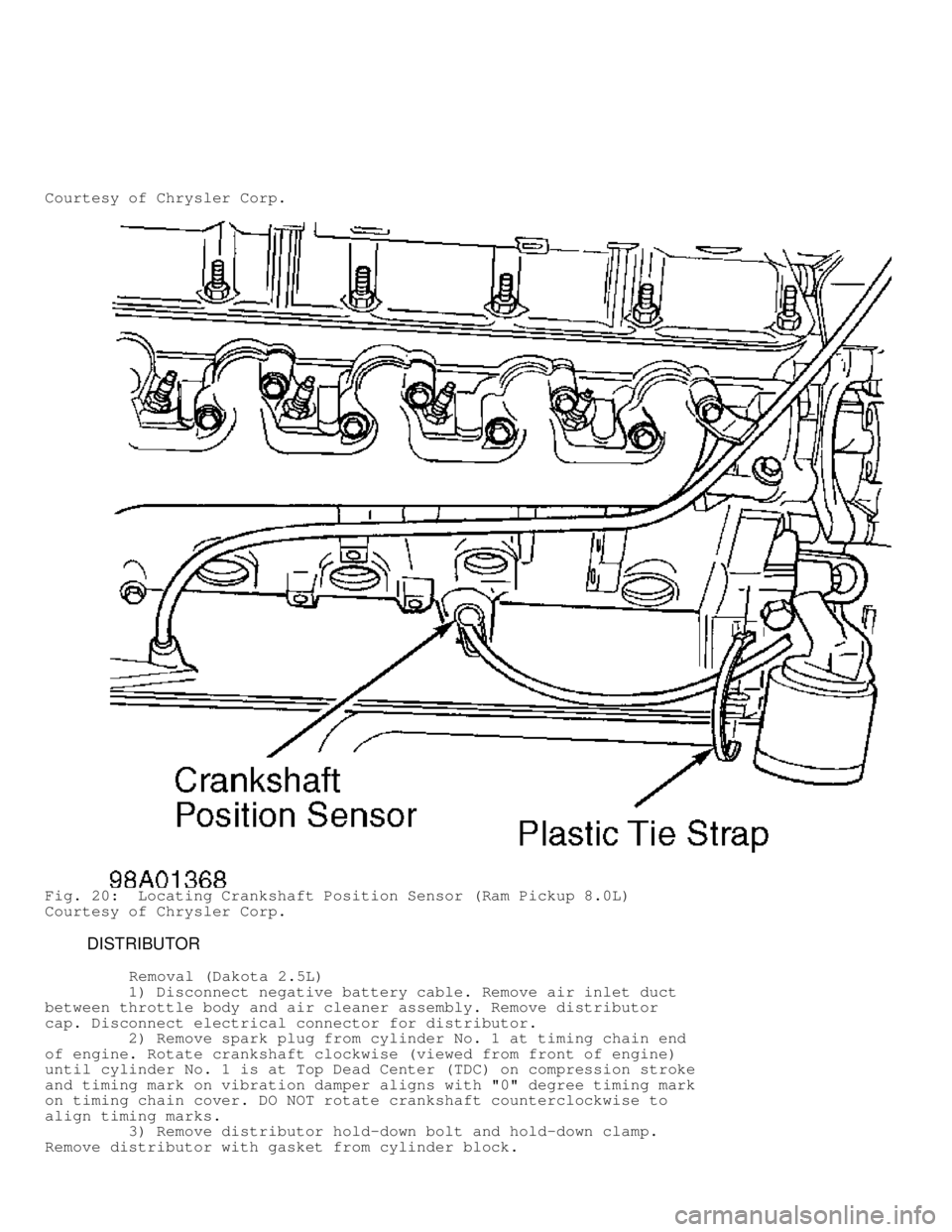
Courtesy of Chrysler Corp.
Fig. 20: Locating Crankshaft Position Sensor (Ram Pickup 8.0L)
Courtesy of Chrysler Corp.
DISTRIBUTOR
Removal (Dakota 2.5L)
1) Disconnect negative battery cable. Remove air inlet duct
between throttle body and air cleaner assembly. Remove distributor
cap. Disconnect electrical connector for distributor.
2) Remove spark plug from cylinder No. 1 at timing chain end
of engine. Rotate crankshaft clockwise (viewed from front of engine)
until cylinder No. 1 is at Top Dead Center (TDC) on compression stroke\
and timing mark on vibration damper aligns with "0" degree timing mark
on timing chain cover. DO NOT rotate crankshaft counterclockwise to
align timing marks.
3) Remove distributor hold-down bolt and hold-down clamp.
Remove distributor with gasket from cylinder block.
Page 965 of 1691
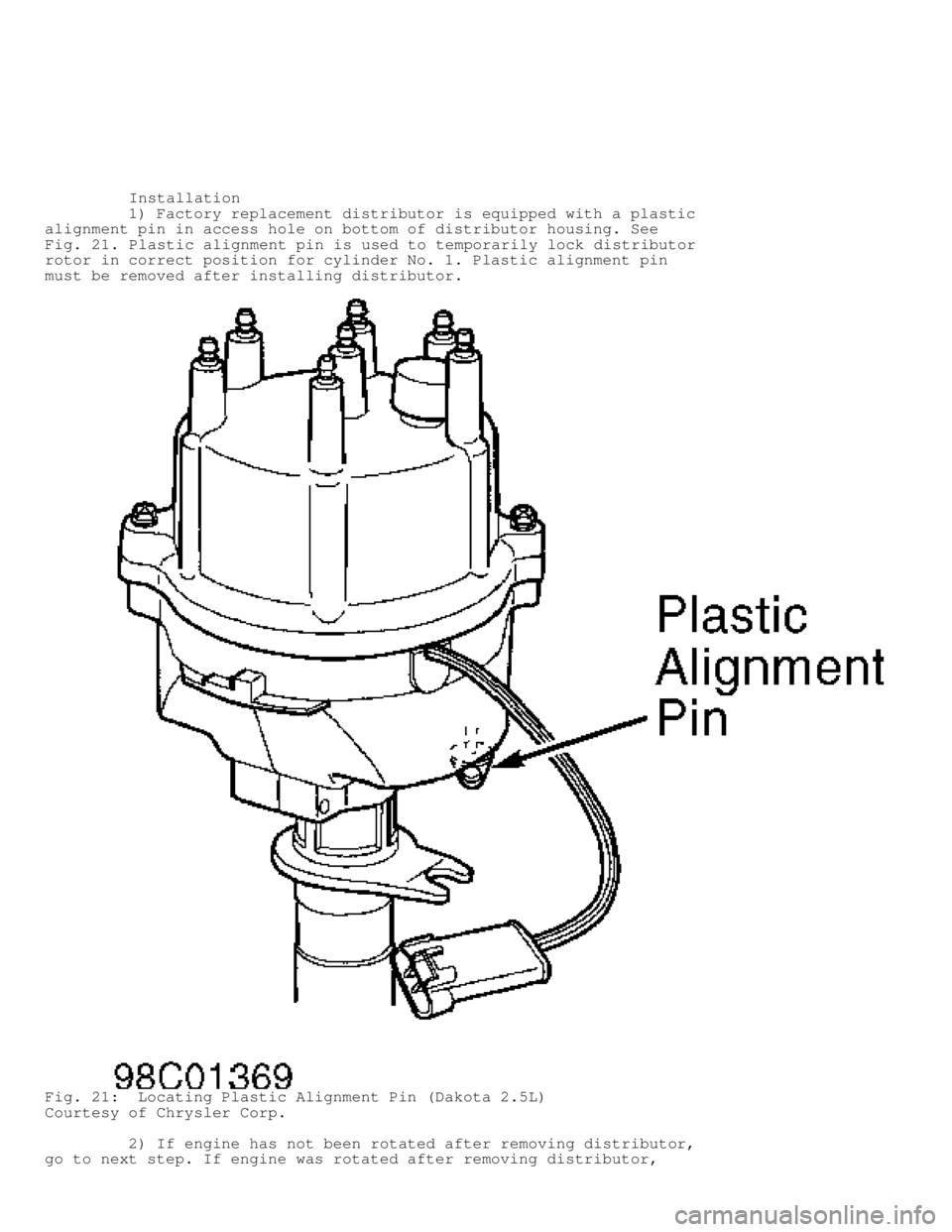
Installation
1) Factory replacement distributor is equipped with a plastic
alignment pin in access hole on bottom of distributor housing. See
Fig. 21 . Plastic alignment pin is used to temporarily lock distributor
rotor in correct position for cylinder No. 1. Plastic alignment pin
must be removed after installing distributor.
Fig. 21: Locating Plastic Alignment Pin (Dakota 2.5L)
Courtesy of Chrysler Corp.
2) If engine has not been rotated after removing distributor,
go to next step. If engine was rotated after removing distributor,
Page 966 of 1691
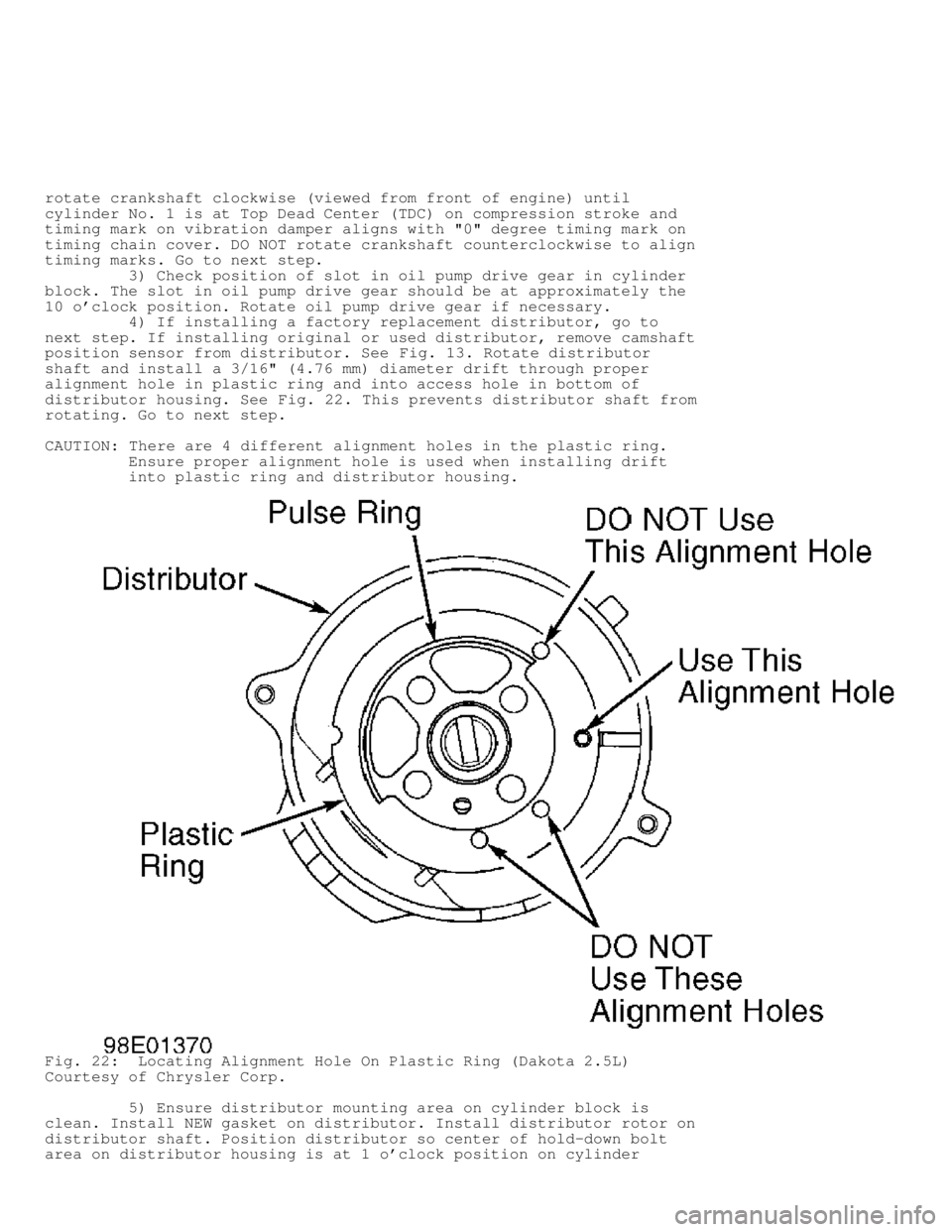
rotate crankshaft clockwise (viewed from front of engine) until
cylinder No. 1 is at Top Dead Center (TDC) on compression stroke and
timing mark on vibration damper aligns with "0" degree timing mark on
timing chain cover. DO NOT rotate crankshaft counterclockwise to align
timing marks. Go to next step.
3) Check position of slot in oil pump drive gear in cylinder
block. The slot in oil pump drive gear should be at approximately the
10 o'clock position. Rotate oil pump drive gear if necessary.
4) If installing a factory replacement distributor, go to
next step. If installing original or used distributor, remove camshaft
position sensor from distributor. See Fig. 13. Rotate distributor
shaft and install a 3/16" (4.76 mm) diameter drift through proper
alignment hole in plastic ring and into access hole in bottom of
distributor housing. See Fig. 22. This prevents distributor shaft from
rotating. Go to next step.
CAUTION: There are 4 different alignment holes in the plastic ring.
Ensure proper alignment hole is used when installing drift
into plastic ring and distributor housing.
Fig. 22: Locating Alignment Hole On Plastic Ring (Dakota 2.5L)
Courtesy of Chrysler Corp.
5) Ensure distributor mounting area on cylinder block is
clean. Install NEW gasket on distributor. Install distributor rotor on
distributor shaft. Position distributor so center of hold-down bolt
area on distributor housing is at 1 o'clock position on cylinder
Page 967 of 1691
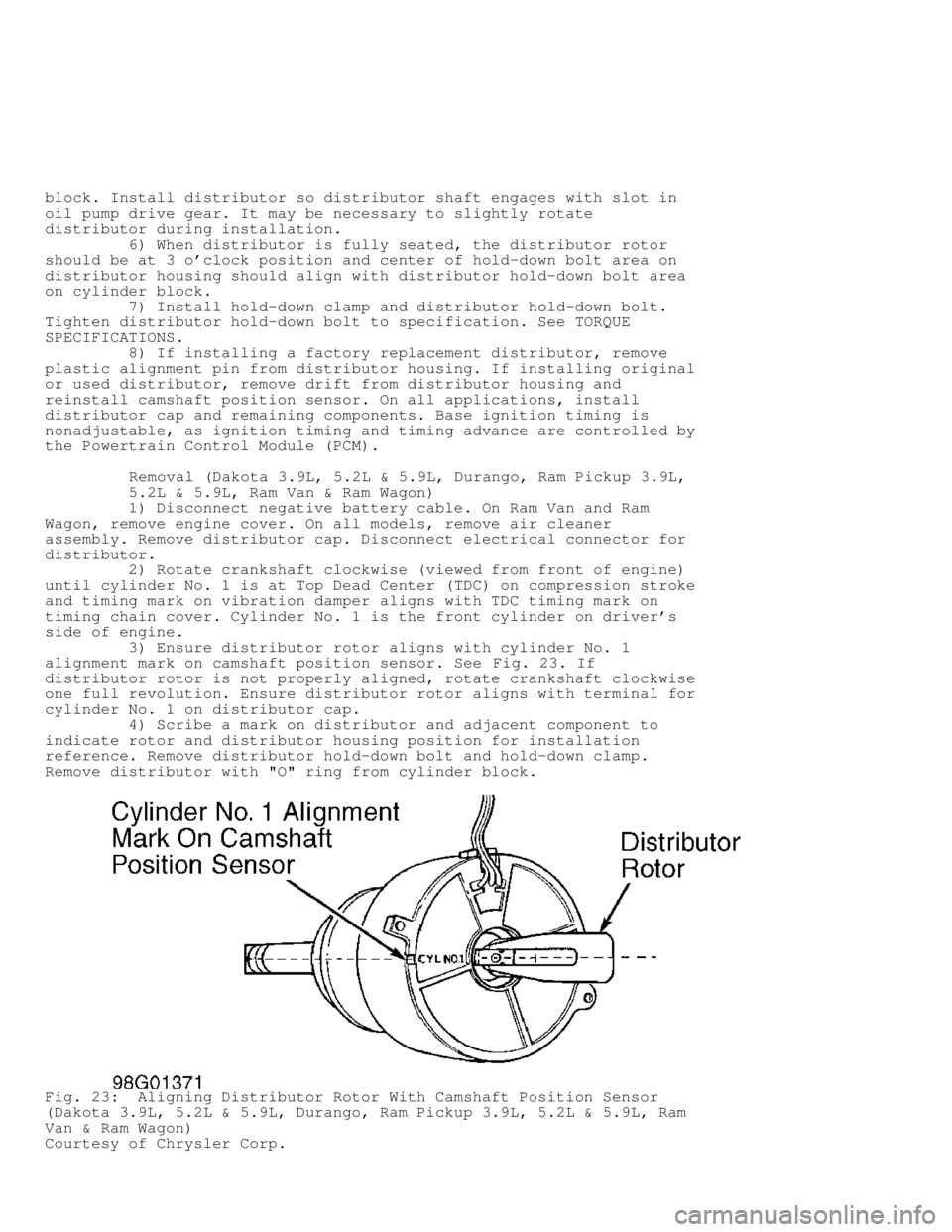
block. Install distributor so distributor shaft engages with slot in
oil pump drive gear. It may be necessary to slightly rotate
distributor during installation.
6) When distributor is fully seated, the distributor rotor
should be at 3 o'clock position and center of hold-down bolt area on
distributor housing should align with distributor hold-down bolt area
on cylinder block.
7) Install hold-down clamp and distributor hold-down bolt.
Tighten distributor hold-down bolt to specification. See TORQUE
SPECIFICATIONS.
8) If installing a factory replacement distributor, remove
plastic alignment pin from distributor housing. If installing original
or used distributor, remove drift from distributor housing and
reinstall camshaft position sensor. On all applications, install
distributor cap and remaining components. Base ignition timing is
nonadjustable, as ignition timing and timing advance are controlled by
the Powertrain Control Module (PCM).
Removal (Dakota 3.9L, 5.2L & 5.9L, Durango, Ram Pickup 3.9L,
5.2L & 5.9L, Ram Van & Ram Wagon)
1) Disconnect negative battery cable. On Ram Van and Ram
Wagon, remove engine cover. On all models, remove air cleaner
assembly. Remove distributor cap. Disconnect electrical connector for
distributor.
2) Rotate crankshaft clockwise (viewed from front of engine)\
until cylinder No. 1 is at Top Dead Center (TDC) on compression stroke\
and timing mark on vibration damper aligns with TDC timing mark on
timing chain cover. Cylinder No. 1 is the front cylinder on driver's
side of engine.
3) Ensure distributor rotor aligns with cylinder No. 1
alignment mark on camshaft position sensor. See Fig. 23. If
distributor rotor is not properly aligned, rotate crankshaft clockwise
one full revolution. Ensure distributor rotor aligns with terminal for
cylinder No. 1 on distributor cap.
4) Scribe a mark on distributor and adjacent component to
indicate rotor and distributor housing position for installation
reference. Remove distributor hold-down bolt and hold-down clamp.
Remove distributor with "O" ring from cylinder block.
Fig. 23: Aligning Distributor Rotor With Camshaft Position Sensor
(Dakota 3.9L, 5.2L & 5.9L, Durango, Ram Pickup 3.9L, 5.2L & 5.9L, Ram
Van & Ram Wagon)
Courtesy of Chrysler Corp.
Page 968 of 1691
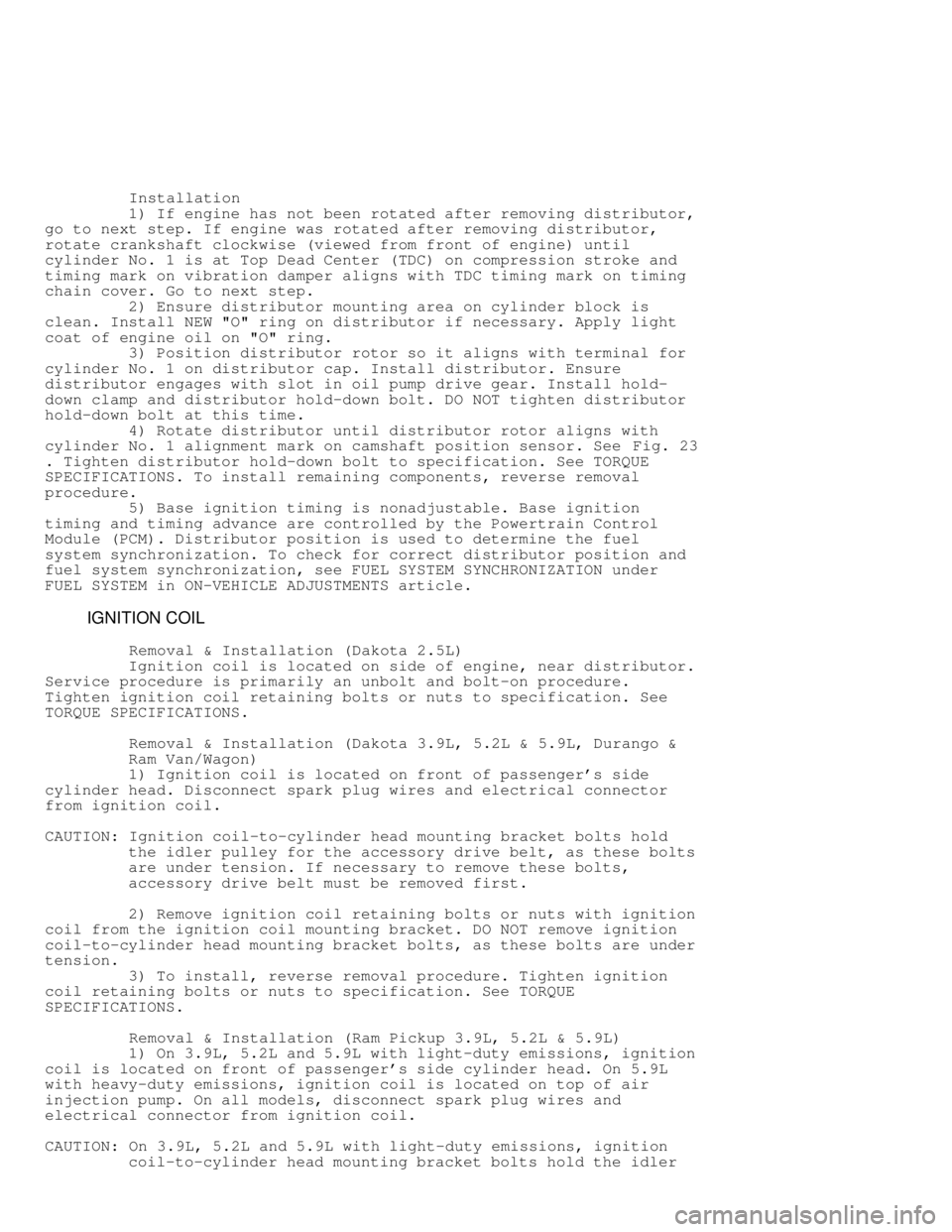
Installation
1) If engine has not been rotated after removing distributor,
go to next step. If engine was rotated after removing distributor,
rotate crankshaft clockwise (viewed from front of engine) until
cylinder No. 1 is at Top Dead Center (TDC) on compression stroke and
timing mark on vibration damper aligns with TDC timing mark on timing
chain cover. Go to next step.
2) Ensure distributor mounting area on cylinder block is
clean. Install NEW "O" ring on distributor if necessary. Apply light
coat of engine oil on "O" ring.
3) Position distributor rotor so it aligns with terminal for
cylinder No. 1 on distributor cap. Install distributor. Ensure
distributor engages with slot in oil pump drive gear. Install hold-
down clamp and distributor hold-down bolt. DO NOT tighten distributor
hold-down bolt at this time.
4) Rotate distributor until distributor rotor aligns with
cylinder No. 1 alignment mark on camshaft position sensor. See Fig. 23
. Tighten distributor hold-down bolt to specification. See TORQUE
SPECIFICATIONS. To install remaining components, reverse removal
procedure.
5) Base ignition timing is nonadjustable. Base ignition
timing and timing advance are controlled by the Powertrain Control
Module (PCM). Distributor position is used to determine the fuel
system synchronization. To check for correct distributor position and
fuel system synchronization, see FUEL SYSTEM SYNCHRONIZATION under
FUEL SYSTEM in ON-VEHICLE ADJUSTMENTS article.
IGNITION COIL
Removal & Installation (Dakota 2.5L)
Ignition coil is located on side of engine, near distributor.
Service procedure is primarily an unbolt and bolt-on procedure.
Tighten ignition coil retaining bolts or nuts to specification. See
TORQUE SPECIFICATIONS.
Removal & Installation (Dakota 3.9L, 5.2L & 5.9L, Durango &
Ram Van/Wagon)
1) Ignition coil is located on front of passenger's side
cylinder head. Disconnect spark plug wires and electrical connector
from ignition coil.
CAUTION: Ignition coil-to-cylinder head mounting bracket bolts hold
the idler pulley for the accessory drive belt, as these bolts
are under tension. If necessary to remove these bolts,
accessory drive belt must be removed first.
2) Remove ignition coil retaining bolts or nuts with ignition
coil from the ignition coil mounting bracket. DO NOT remove ignition
coil-to-cylinder head mounting bracket bolts, as these bolts are under
tension.
3) To install, reverse removal procedure. Tighten ignition
coil retaining bolts or nuts to specification. See TORQUE
SPECIFICATIONS.
Removal & Installation (Ram Pickup 3.9L, 5.2L & 5.9L)
1) On 3.9L, 5.2L and 5.9L with light-duty emissions, ignition
coil is located on front of passenger's side cylinder head. On 5.9L
with heavy-duty emissions, ignition coil is located on top of air
injection pump. On all models, disconnect spark plug wires and
electrical connector from ignition coil.
CAUTION: On 3.9L, 5.2L and 5.9L with light-duty emissions, ignition
coil-to-cylinder head mounting bracket bolts hold the idler
Page 971 of 1691
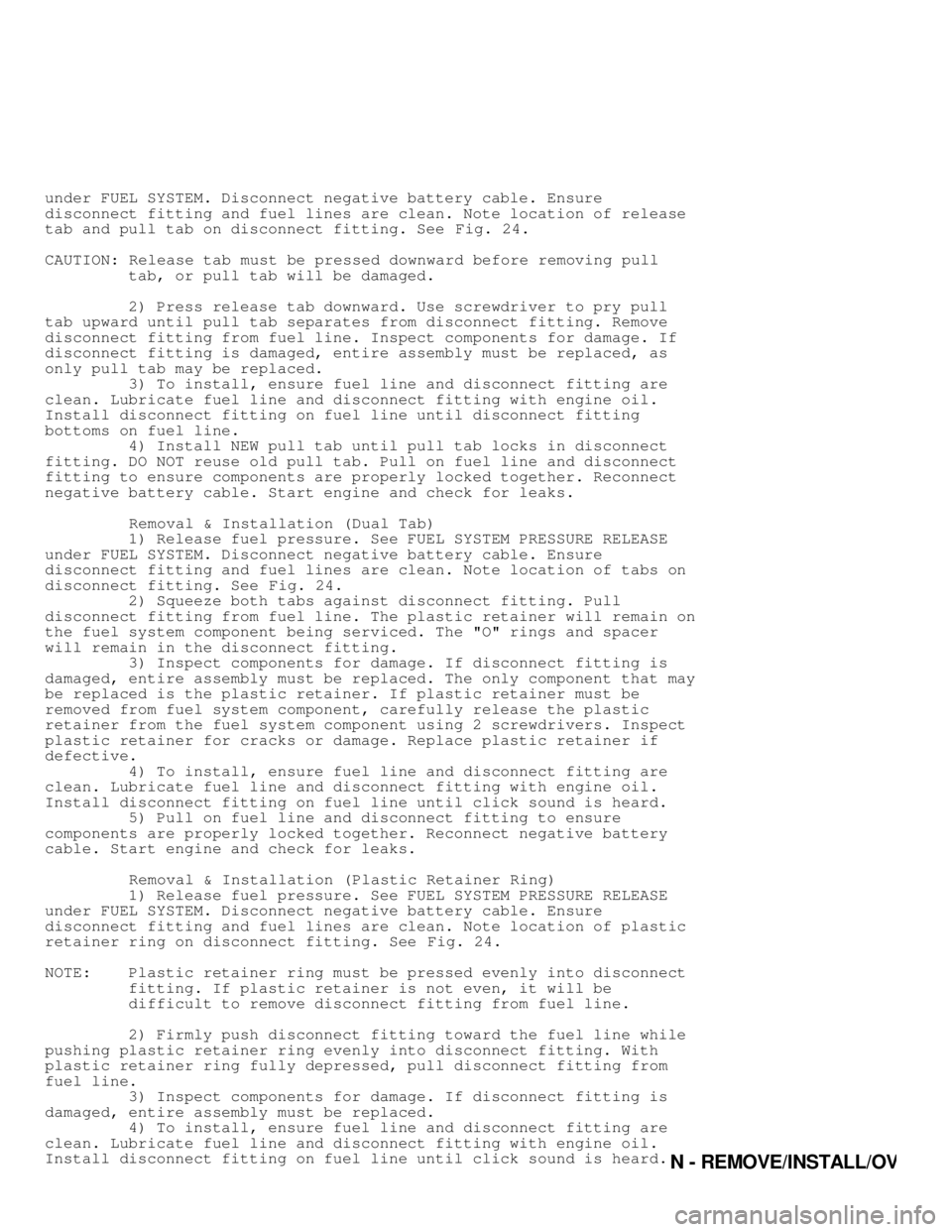
N - R EM OVE /IN STA LL/O VER HAU L
under FUEL SYSTEM. Disconnect negative battery cable. Ensure disconnect fitting and fuel lines are clean. Note location of releasetab and pull tab on disconnect fitting. See Fig. 24.
CAUTION: Release tab must be pressed downward before removing pull
tab, or pull tab will be damaged. 2) Press release tab downward. Use screwdriver to pry pull tab upward until pull tab separates from disconnect fitting. Removedisconnect fitting from fuel line. Inspect components for damage. Ifdisconnect fitting is damaged, entire assembly must be replaced, asonly pull tab may be replaced. 3) To install, ensure fuel line and disconnect fitting areclean. Lubricate fuel line and disconnect fitting with engine oil.Install disconnect fitting on fuel line until disconnect fittingbottoms on fuel line. 4) Install NEW pull tab until pull tab locks in disconnectfitting. DO NOT reuse old pull tab. Pull on fuel line and disconnectfitting to ensure components are properly locked together. Reconnectnegative battery cable. Start engine and check for leaks. Removal & Installation (Dual Tab)
1) Release fuel pressure. See FUEL SYSTEM PRESSURE RELEASE under FUEL SYSTEM. Disconnect negative battery cable. Ensuredisconnect fitting and fuel lines are clean. Note location of tabs ondisconnect fitting. See Fig. 24.
2) Squeeze both tabs against disconnect fitting. Pulldisconnect fitting from fuel line. The plastic retainer will remain onthe fuel system component being serviced. The "O" rings and spacerwill remain in the disconnect fitting. 3) Inspect components for damage. If disconnect fitting isdamaged, entire assembly must be replaced. The only component that maybe replaced is the plastic retainer. If plastic retainer must beremoved from fuel system component, carefully release the plasticretainer from the fuel system component using 2 screwdrivers. Inspectplastic retainer for cracks or damage. Replace plastic retainer ifdefective. 4) To install, ensure fuel line and disconnect fitting areclean. Lubricate fuel line and disconnect fitting with engine oil.Install disconnect fitting on fuel line until click sound is heard. 5) Pull on fuel line and disconnect fitting to ensurecomponents are properly locked together. Reconnect negative batterycable. Start engine and check for leaks. Removal & Installation (Plastic Retainer Ring)
1) Release fuel pressure. See FUEL SYSTEM PRESSURE RELEASE under FUEL SYSTEM. Disconnect negative battery cable. Ensuredisconnect fitting and fuel lines are clean. Note location of plasticretainer ring on disconnect fitting. See Fig. 24.
NOTE: Plastic retainer ring must be pressed evenly into disconnect fitting. If plastic retainer is not even, it will be difficult to remove disconnect fitting from fuel line. 2) Firmly push disconnect fitting toward the fuel line while pushing plastic retainer ring evenly into disconnect fitting. Withplastic retainer ring fully depressed, pull disconnect fitting fromfuel line. 3) Inspect components for damage. If disconnect fitting isdamaged, entire assembly must be replaced. 4) To install, ensure fuel line and disconnect fitting areclean. Lubricate fuel line and disconnect fitting with engine oil.Install disconnect fitting on fuel line until click sound is heard.
Page 972 of 1691
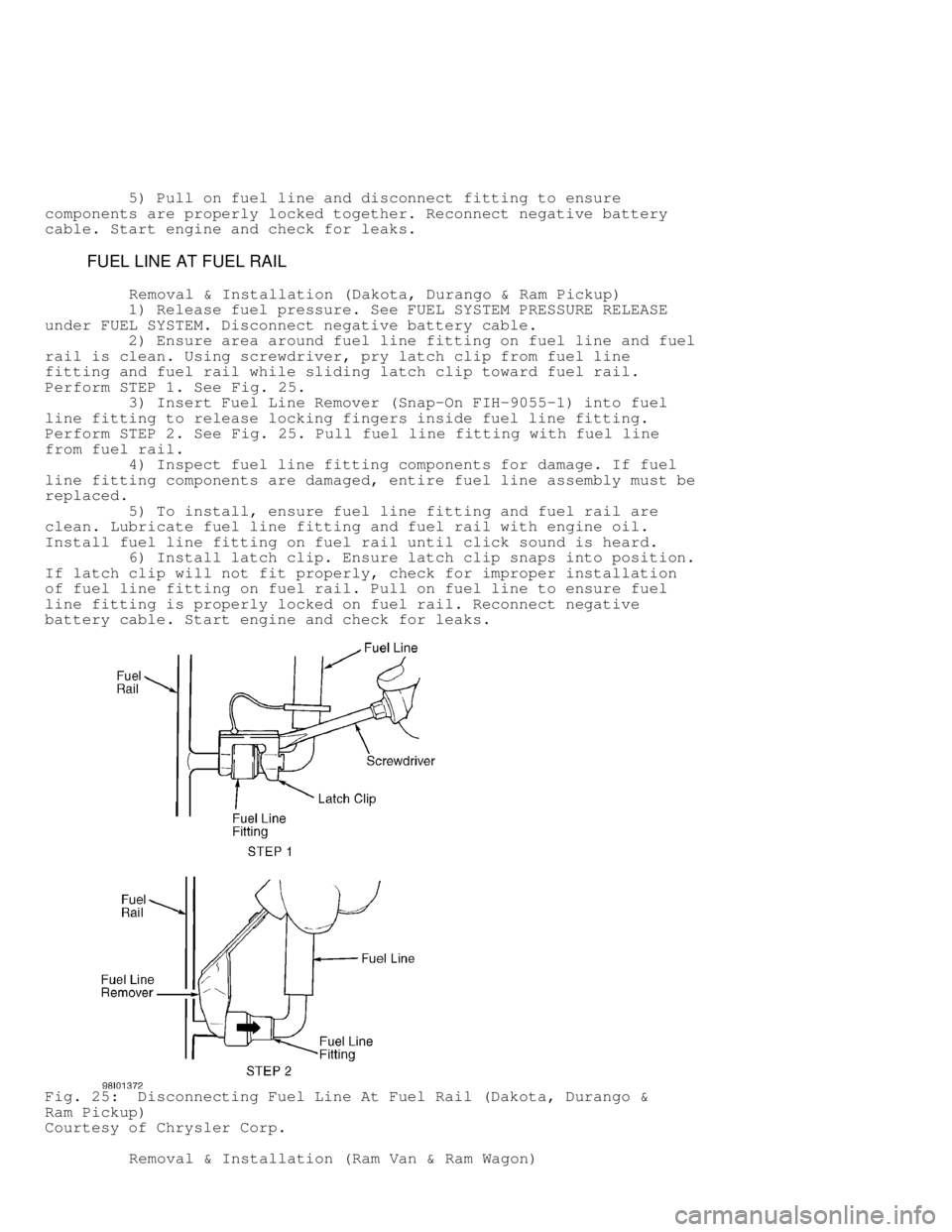
5) Pull on fuel line and disconnect fitting to ensure
components are properly locked together. Reconnect negative battery
cable. Start engine and check for leaks.
FUEL LINE AT FUEL RAIL
Removal & Installation (Dakota, Durango & Ram Pickup)
1) Release fuel pressure. See FUEL SYSTEM PRESSURE RELEASE
under FUEL SYSTEM. Disconnect negative battery cable.
2) Ensure area around fuel line fitting on fuel line and fuel
rail is clean. Using screwdriver, pry latch clip from fuel line
fitting and fuel rail while sliding latch clip toward fuel rail.
Perform STEP 1. See Fig. 25.
3) Insert Fuel Line Remover (Snap-On FIH-9055-1) into fuel
line fitting to release locking fingers inside fuel line fitting.
Perform STEP 2. See Fig. 25. Pull fuel line fitting with fuel line
from fuel rail.
4) Inspect fuel line fitting components for damage. If fuel
line fitting components are damaged, entire fuel line assembly must be
replaced.
5) To install, ensure fuel line fitting and fuel rail are
clean. Lubricate fuel line fitting and fuel rail with engine oil.
Install fuel line fitting on fuel rail until click sound is heard.
6) Install latch clip. Ensure latch clip snaps into position.
If latch clip will not fit properly, check for improper installation
of fuel line fitting on fuel rail. Pull on fuel line to ensure fuel
line fitting is properly locked on fuel rail. Reconnect negative
battery cable. Start engine and check for leaks.
Fig. 25: Disconnecting Fuel Line At Fuel Rail (Dakota, Durango &
Ram Pickup)
Courtesy of Chrysler Corp.
Removal & Installation (Ram Van & Ram Wagon)
Page 973 of 1691
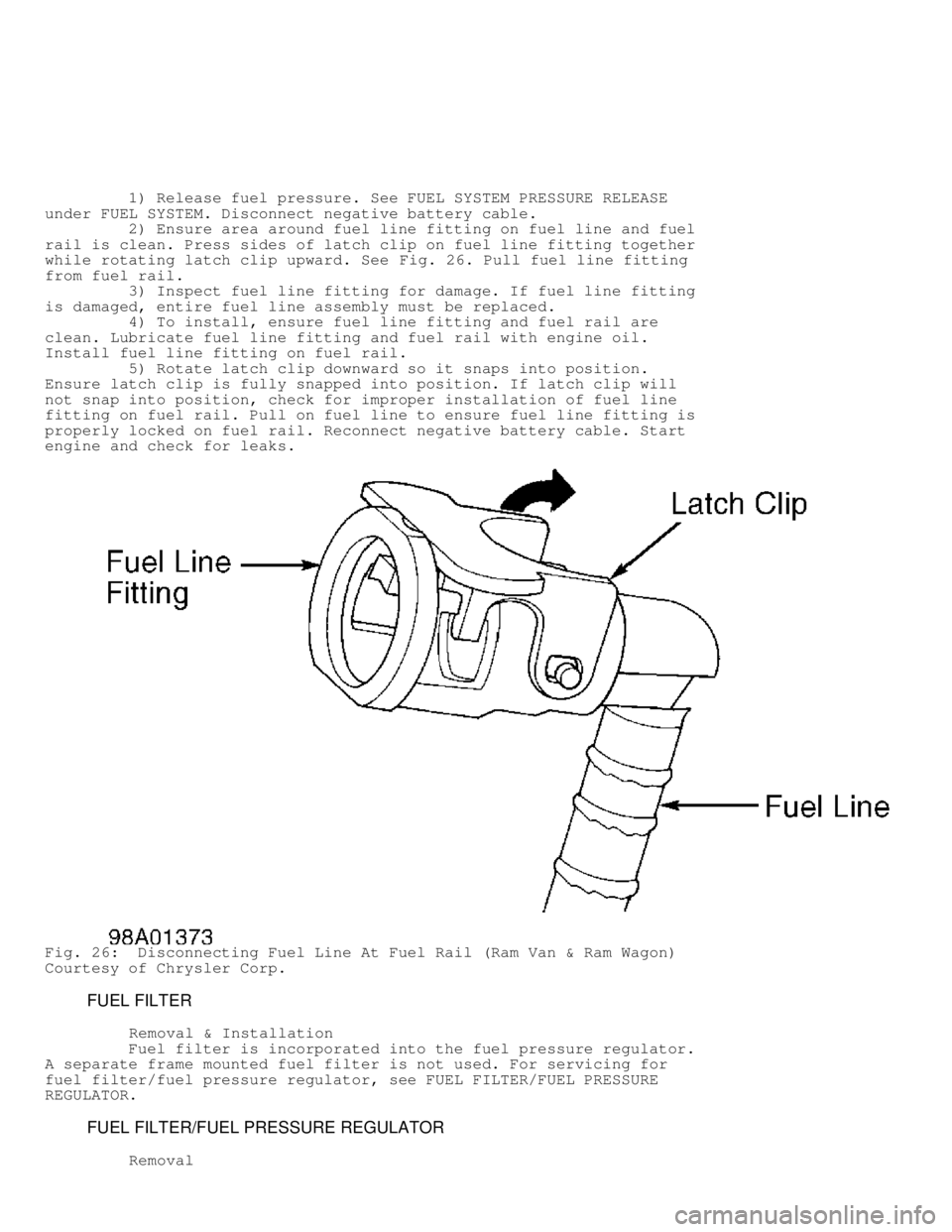
1) Release fuel pressure. See FUEL SYSTEM PRESSURE RELEASE
under FUEL SYSTEM. Disconnect negative battery cable.
2) Ensure area around fuel line fitting on fuel line and fuel
rail is clean. Press sides of latch clip on fuel line fitting together
while rotating latch clip upward. See Fig. 26. Pull fuel line fitting
from fuel rail.
3) Inspect fuel line fitting for damage. If fuel line fitting
is damaged, entire fuel line assembly must be replaced.
4) To install, ensure fuel line fitting and fuel rail are
clean. Lubricate fuel line fitting and fuel rail with engine oil.
Install fuel line fitting on fuel rail.
5) Rotate latch clip downward so it snaps into position.
Ensure latch clip is fully snapped into position. If latch clip will
not snap into position, check for improper installation of fuel line
fitting on fuel rail. Pull on fuel line to ensure fuel line fitting is
properly locked on fuel rail. Reconnect negative battery cable. Start
engine and check for leaks.
Fig. 26: Disconnecting Fuel Line At Fuel Rail (Ram Van & Ram Wagon)
Courtesy of Chrysler Corp.
FUEL FILTER
Removal & Installation
Fuel filter is incorporated into the fuel pressure regulator.
A separate frame mounted fuel filter is not used. For servicing for
fuel filter/fuel pressure regulator, see FUEL FILTER/FUEL PRESSURE
REGULATOR.
FUEL FILTER/FUEL PRESSURE REGULATOR
Removal